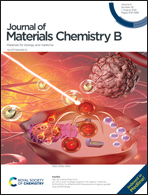Hyperbranched polymer with dynamic thiol–aldehyde crosslinking and its application as a self-healable bioadhesive†
Abstract
Bioadhesives crosslinked with dynamic bonds exhibit shear-thinning, self-healing, and on-demand detachment properties, but generally show a weak bonding performance due to their poor bulk strength. Obtaining a strong bioadhesive with reversible crosslinking remains a challenge. To address this issue, herein we engineered a dynamic thiol–aldehyde crosslinked solvent-free adhesive based on hyperbranched polymer. The adhesive was obtained by directly mixing a liquid hyperbranched polymer with thiol end groups (HBPTE) and benzaldehyde-terminated polyethylene glycol (PEGCHO) without any additional catalyst or solvent. The solvent-free strategy yielded a dense crosslinking structure with many aldehyde groups, so this HBPTE–PEGCHO adhesive can strongly bond to tissue and various non-biological substrates. In addition, the HBPTE–PEGCHO adhesive has self-healing and thermo-reversible bonding properties due to the dynamic thiol–aldehyde crosslinking matrix. In vivo wound healing experiments show that this HBPTE–PEGCHO adhesive is tissue-benign, suggesting it can be applied in clinical practice. Combining the hyperbranched polymer-based solvent-free strategy and dynamic thiol–aldehyde crosslinking chemistry provides a simple but effective way to engineer a multifunctional bioadhesive with the desired bonding performance.



 Please wait while we load your content...
Please wait while we load your content...